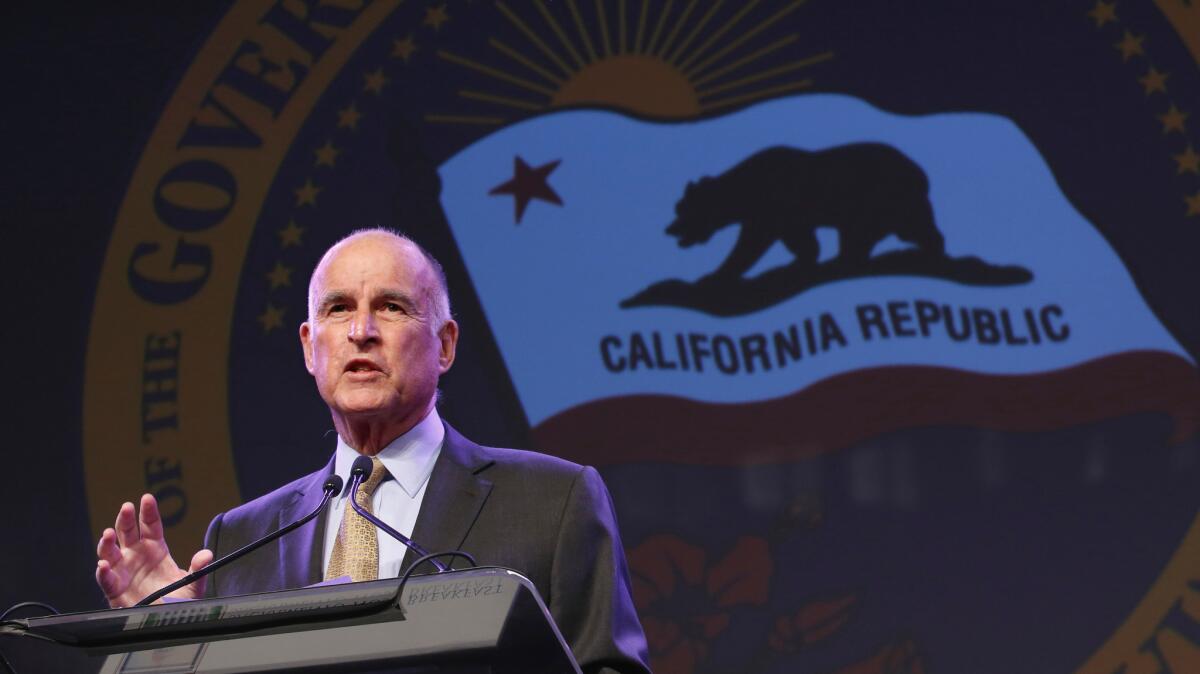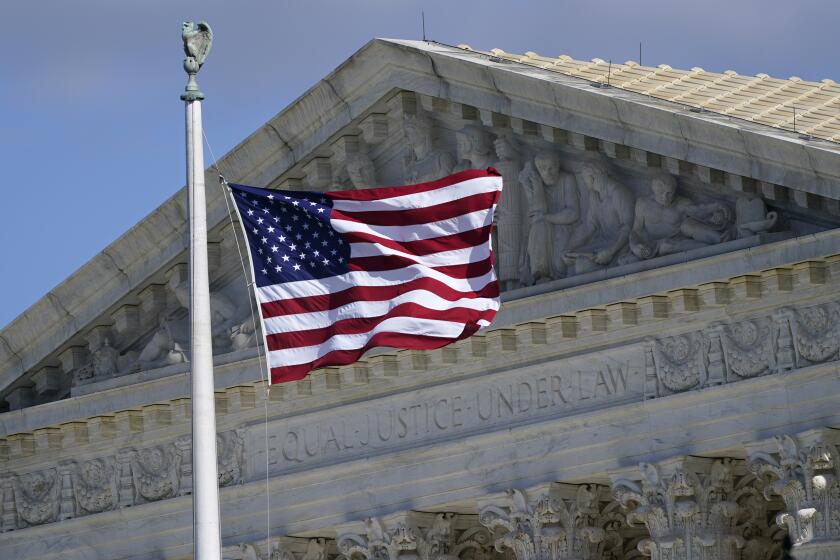With climate legislation stalling, Jerry Brown looks to potential fight at the ballot box

- Share via
Reporting from Sacramento — The battle to extend California’s climate policies could grind to a halt this year, but Gov. Jerry Brown plans to continue pressing the issue before his final term in office ends — even if that requires a ballot measure campaign in 2018.
The commitment from Brown, detailed in a statement from his top aide, Nancy McFadden, came after a flurry of activity in the Capitol on Thursday that revealed the narrow chances of passing climate measures before the end of the legislative session on Aug. 31.
Environmental advocates and some lawmakers have wanted new laws this month to extend the state’s targets for reducing greenhouse gas emissions and to safeguard the cap-and-trade program, which limits how much greenhouse gas can be emitted into the atmosphere and requires companies to obtain permits to pollute. The system has faced legal and political headwinds.
Powerful oil companies have lined up in opposition to the legislation, and it’s unclear whether any measure would pass muster with business-friendly Democrats in the Assembly.
McFadden said the fate of legislation this year won’t “make or break our climate agenda,” but she didn’t outline a clear path forward, saying it would “play into the hands of oil companies by telegraphing our strategy.”
“We are going to extend our climate goals and cap-and-trade program — one way or another,” McFadden said. “The governor will continue working with the Legislature to get this done this year, next year, or on the ballot in 2018.”
The governor’s team followed up by creating a fundraising account for a potential ballot measure campaign, called “Californians for a Clean Environment.”
The cap-and-trade program, which serves as the centerpiece of California’s climate policies, was created under AB 32, a 2006 measure that sets a target for reducing emissions to 1990 levels by 2020. There are legal doubts about whether the program can continue past that deadline, leading to a push for a new law to keep it rolling.
Top Democrats spent Thursday huddled in a series of meetings about climate policies, but they were unable to reach an agreement on next steps, according to sources who declined to speak publicly about the private conversations.
Senate leader Kevin de León (D-Los Angeles) wants to pass a measure from Sen. Fran Pavley (D-Agoura Hills) that would establish new, steeper targets for reducing greenhouse gas emissions. The bill, SB 32, would set a goal of cutting emissions to 40% below 1990 levels by 2030.
De León, who said this week that he would not “negotiate a bad deal just to get it done,” indicated Thursday that he still wants to see prompt action.
“This is going to get done one way or the other. I’d sure like to get it done sooner rather than later,” he said. “It takes a tri-party agreement to actually make this come to reality.”
But Brown has his sights set on crafting a measure that would receive support from two-thirds of lawmakers in each house of the Legislature, a higher threshold that would safeguard the cap-and-trade program from legal challenges.
The governor is counting on using revenue from cap and trade to help pay for the bullet train project from Los Angeles to San Francisco. But the program is facing a lawsuit over whether it’s an unconstitutional tax, casting doubt on the funding plan.
Meanwhile, Assembly Speaker Anthony Rendon (D-Paramount) wants to hold off on the issue until next year, fearing there isn’t enough support in his chamber to pass the measure. Business-friendly Democrats hold more sway in the Assembly, where they also blocked a proposal to slash oil use for transportation last year.
In a statement Thursday, Rendon called for a cautious approach.
“The world needs California’s continued leadership to advance the fight against climate change, so it is vital that the solutions we put forward are as strong and as solid as possible,” Rendon said.
“As Senate President pro Tem De León noted yesterday and the governor’s office reiterated today, we are committed to extending California’s emission targets beyond 2020, and we will keep working on this until it’s right.”
The lack of consensus has frustrated environmental advocates, who want to see a concerted effort to pass legislation as soon as possible. They sent a letter to the governor Thursday to “strongly urge” him “not to give up on climate legislation this year.”
“There is much to be done and with more than three weeks of the legislative session, there is time to build agreement on a pathway that will solidify California’s commitment and ability to achieve your 2030 carbon pollution reduction target,” wrote representatives from the Natural Resources Defense Council, Environment California and the League of Conservation Voters, among others.
Jason Barbose, western states policy manager for the Union of Concerned Scientists, said lawmakers shouldn’t drop their efforts before the end of the session.
“It’s not an easy lift,” he said. “But there’s real opportunity.”
If legislation isn’t successful in the Capitol, Brown could decide to move forward with a ballot measure in 2018.
Environmental advocates have a mixed record when it comes to battling oil companies at the ballot box. A proposal for an oil extraction tax was defeated in 2006 when the industry unleashed more than $90 million against it, swamping the $60 million spent in favor.
But advocates were able to protect California’s climate policies from a ballot campaign in 2010.
Brown had $23 million in his fundraising account for ballot measures as of June. He may end up spending some of that money on his campaign to reduce the state prison population by making more inmates eligible for parole.
Follow @chrismegerian and @melmason on Twitter, sign up for our daily Essential Politics newsletter and listen to the weekly California Politics Podcast
ALSO:
A grand bargain? Gov. Jerry Brown in talks with oil companies about climate change programs
California’s cap-and-trade program faces daunting hurdles to avoid collapse
More to Read
Get the L.A. Times Politics newsletter
Deeply reported insights into legislation, politics and policy from Sacramento, Washington and beyond. In your inbox three times per week.
You may occasionally receive promotional content from the Los Angeles Times.











